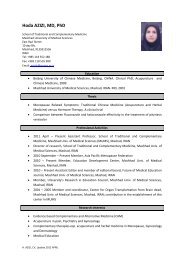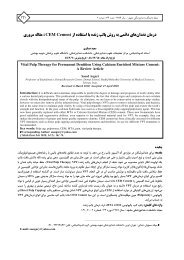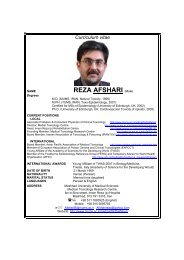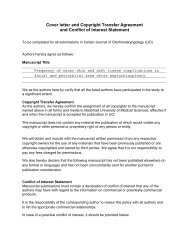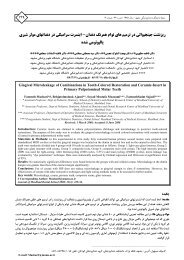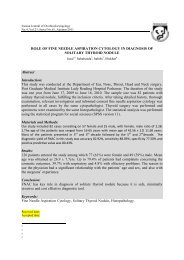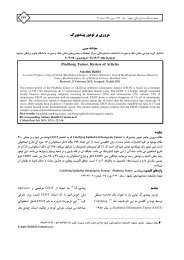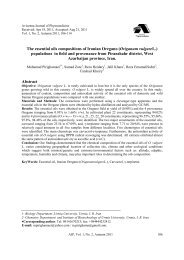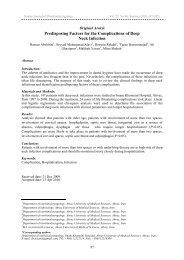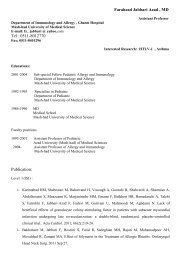Oral Lesions at Birth
Oral Lesions at Birth
Oral Lesions at Birth
You also want an ePaper? Increase the reach of your titles
YUMPU automatically turns print PDFs into web optimized ePapers that Google loves.
The Iranian Journal of Otorhinolaryngology<br />
2005<br />
.،،،<br />
The aim of this study was to determine the<br />
frequency of the lesions in first exam in<br />
newborn.<br />
This d<strong>at</strong>a is important in order to detect<br />
differences in geographic areas, diagnosis<br />
line tendencies and for clinicians to perform<br />
judgment to evalu<strong>at</strong>e the pedi<strong>at</strong>ric p<strong>at</strong>ients<br />
before the biopsy and management of<br />
pedi<strong>at</strong>ric oral lesions .<br />
M<strong>at</strong>erials and methods<br />
All babies delivered in sina hospital were<br />
examined for oral lesions as cross sectional<br />
descriptive study since 1.1.82 for 12<br />
months. The mouth of the newborn was<br />
examined while the child was lying on the<br />
examin<strong>at</strong>ion table. The interior of the mouth<br />
was evalu<strong>at</strong>ed with a light and tongue blade<br />
with well washed hands. Frequency<br />
distribution was detected.<br />
Results<br />
During one year , s study 3298 babies<br />
were delivered in sina hospital. As shown in<br />
the Table oral lesions include 76% epstien<br />
pearl, 35% Bohn nodule,0.33%ankyloglossia,<br />
0.12% n<strong>at</strong>al teeth, 0.03% congenital<br />
epulis (0.6/1000 live birth),0.03 % cleft lip<br />
(0.3 in / 1000 live birth), 0.06% cleft pal<strong>at</strong>e<br />
(0.6 in / 1000 live birth), 0.03% cleft lip<br />
and pal<strong>at</strong>e(0.3in/ 1000 live birth).<br />
Discussion<br />
The mouth of the newborn is<br />
characterized by toothless alveolar pads or<br />
ridges in the maxilla and mandible. In a<br />
healthy infant, the mother should be present<br />
during complete examin<strong>at</strong>ion; even minor,<br />
seemingly insignificant, an<strong>at</strong>omic vari<strong>at</strong>ion<br />
may worry a family and should be<br />
explained.<br />
Several types of dental cysts rel<strong>at</strong>ed to<br />
embryonic structures may present <strong>at</strong> birth.<br />
Epstein pearls and Bohn nodules occur in<br />
approxim<strong>at</strong>ely %80 of newborns(3).<br />
Epstein pearls are white yellow cysts<br />
occurring along the median pal<strong>at</strong>al raphes or<br />
<strong>at</strong> the junction of the hard and soft pal<strong>at</strong>es.<br />
They result from remnant of epithelial tissue<br />
entrapped during pal<strong>at</strong>al fusion. In this study<br />
76% of newborns had Epstein pearls.<br />
No.41, Autumn-<br />
Bohn nodules are white yellow cysts<br />
occurring along the l<strong>at</strong>eral aspects of the<br />
alveolar ridges and along the periphery of<br />
the pal<strong>at</strong>e. They may develop from<br />
heterotrophic salivary gland tissue or from<br />
remnants of the dental lamina. No tre<strong>at</strong>ment<br />
is necessary. About 35% of our babies had<br />
Bohn nodules(figure 3 ).<br />
Dental lamina Cysts<br />
Dental lamina cysts are fluid filled cystic<br />
form<strong>at</strong>ions found on the crest of the alveolar<br />
ridges, in most cases they are asymptom<strong>at</strong>ic<br />
and regress spontaneously; however, if they<br />
interfere with e<strong>at</strong>ing, surgical intervention<br />
may be indic<strong>at</strong>ed.<br />
The frenulum lingua is a band of tissue th<strong>at</strong><br />
connects the floor of the mouth to the tongue<br />
(ankyloglossia) (figure 4,5).<br />
Ankyloglossia<br />
Frenulum of Maxilla<br />
4



